When it comes to crafting a wardrobe that aligns with your style and lifestyle, the choice of fabric is just as crucial as the cut, colour, or design. Understanding the properties of different fabrics can help you make more informed decisions, ensuring that your clothes not only look good but also feel comfortable, stand the test of time, and suit your day-to-day needs. Let's take a deep dive into some of the most common fabrics and blends, exploring their unique characteristics and how they affect wear, care, and overall performance.
1. Cotton: The Everyday Essential
Properties: Cotton is a natural fibre that's breathable, soft, and versatile. It's a staple in many wardrobes due to its comfort and durability.
How It Wears: Cotton is comfortable against the skin and can be worn year-round, though it's especially favoured for warm-weather wear. It holds its shape reasonably well but can stretch out over time, especially in high-stress areas like elbows and knees.
Laundering Needs: Cotton is generally easy to care for, but it can shrink if not washed properly. It's best washed in cold or warm water and can be tumble-dried on low. Over time, repeated washing can lead to fading and a softer, lived-in feel.
Crease Resistance: Cotton tends to wrinkle easily, which is why you'll often see blends like cotton-polyester, which reduce this tendency. A quick iron or steam can remedy this.
Breathability: Highly breathable, making it a top choice for summer garments.
Pilling/Wear: Cotton can pill over time, especially in lower-quality weaves or knits. However, it generally holds up well, particularly in heavier weights.
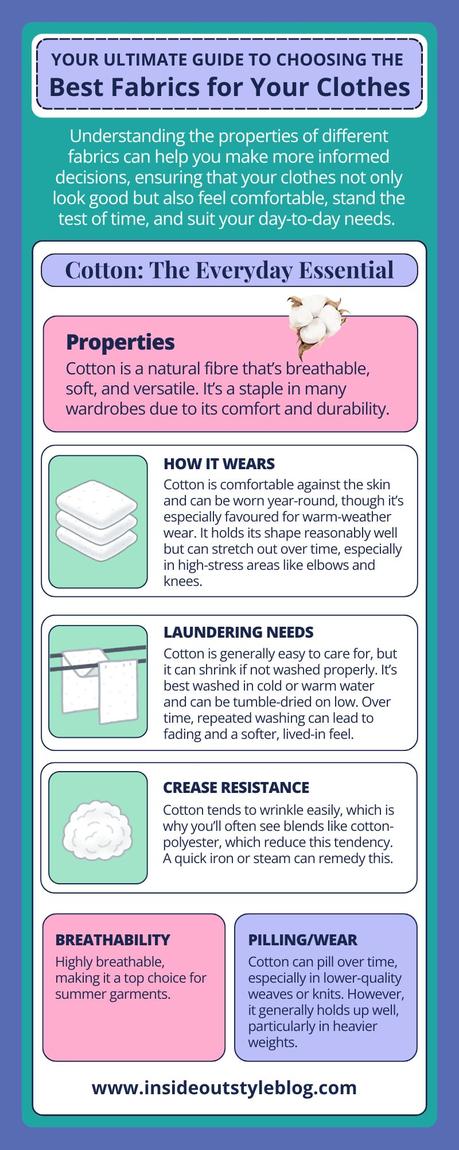 2. Linen: The Summer Savior
2. Linen: The Summer Savior

Properties: Linen is made from the fibres of the flax plant and is known for its lightweight, breathable, and cooling properties.
How It Wears: Linen is perfect for hot weather as it allows air to circulate freely. However, it can be quite stiff and can take a few wears to soften up.
Laundering Needs: Linen requires gentle care. It's best washed in cold water and air-dried to prevent shrinkage and maintain its natural texture. Over time, linen softens and becomes more comfortable.
Crease Resistance: Linen is notorious for wrinkling. Embrace its relaxed, lived-in look, or be prepared to iron or steam it frequently.
Breathability: One of the most breathable fabrics, making it ideal for summer.
Pilling/Wear: Linen is durable and doesn't pill easily, but it can wear thin in high-friction areas.
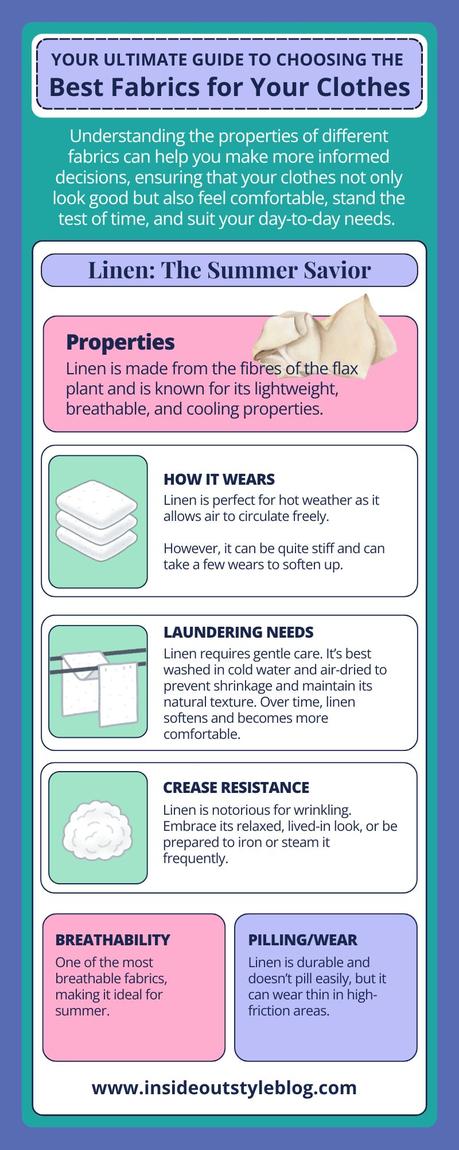 3. Silk: The Luxurious Delicate
3. Silk: The Luxurious Delicate

Properties: Silk is a natural protein fibre known for its softness, sheen, and luxurious feel. It drapes beautifully and is often used in more formal garments.
How It Wears: Silk feels cool to the touch and is excellent for draping styles. It's delicate, so it requires mindful wearing to prevent snags or pulls.
Laundering Needs: Silk should be washed gently, preferably by hand or on a delicate cycle in cold water with a pH-neutral detergent. It's best air-dried, away from direct sunlight to avoid weakening the fibers.
Crease Resistance: Silk doesn't crease as much as cotton or linen but can develop wrinkles over time. It's best to steam rather than iron silk to avoid damage.
Breathability: It's breathable but not as much as cotton or linen, making it more suitable for moderate temperatures.
Pilling/Wear: Silk can wear out and become thin in high-use areas and may develop runs if not handled with care.
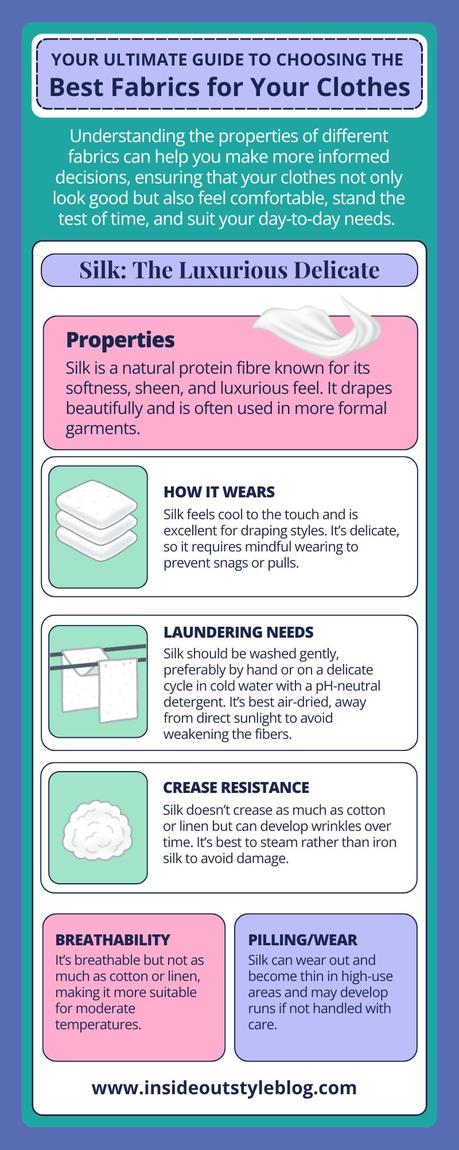 4. Wool: The Winter Warmer
4. Wool: The Winter Warmer

Properties: Wool is a natural fibre derived from sheep and other animals. It's insulating, breathable, and can absorb moisture without feeling wet. There are a variety of different wools which are listed out below.
How It Wears: Wool is perfect for colder climates as it retains heat well. It's resilient and can return to its original shape after being stretched.
Laundering Needs: Wool requires careful handling. It's best dry-cleaned or washed in cold water with a gentle wool-specific detergent. Always air-dry to prevent shrinking or felting.
Crease Resistance: Wool has a natural resistance to wrinkles, making it a great choice for suits and coats.
Breathability: Wool is surprisingly breathable and can regulate temperature well, making it comfortable across various climates.
Pilling/Wear: Wool can pill, especially in areas of friction, but higher-quality wool fabrics pill less and wear better over time.
 5. Polyester: The Practical Performer
5. Polyester: The Practical Performer

Properties: Polyester is a synthetic fibre known for its durability, wrinkle resistance, and versatility. It's often blended with natural fibres to enhance their properties.
How It Wears: Polyester is lightweight, dries quickly, and holds its shape well. It can feel less breathable than natural fibres, making it less comfortable in high heat.
Laundering Needs: Polyester is easy to care for and can be machine-washed and dried without fear of shrinking. It's resistant to fading and wrinkling.
Crease Resistance: Polyester is highly resistant to creasing, making it a low-maintenance choice.
Breathability: It's less breathable than natural fibres, which can make it feel clammy in hot weather.
Pilling/Wear: Polyester can pill, especially when blended with other fibres, but it's generally durable and holds up well to wear and tear.
 6. Rayon: The Versatile Imitator
6. Rayon: The Versatile Imitator

Properties: Rayon is a semi-synthetic fibre made from cellulose, often derived from wood pulp. It's soft, breathable, and drapes beautifully, making it a popular substitute for silk and cotton.
How It Wears: Rayon feels light and smooth against the skin, making it ideal for dresses, blouses, and skirts. It's comfortable in warm weather but can lose its shape if not handled properly.
Laundering Needs: Rayon is delicate and should be hand-washed or washed on a gentle cycle in cold water. It can shrink and distort with high heat, so it's best to air-dry it flat.
Crease Resistance: Rayon wrinkles easily but can be ironed on a low setting with a pressing cloth.
Breathability: Highly breathable, making it suitable for warm climates.
Pilling/Wear: Rayon can pill over time and is prone to abrasion, especially in lower-quality weaves. It may also stretch out of shape with repeated wear.
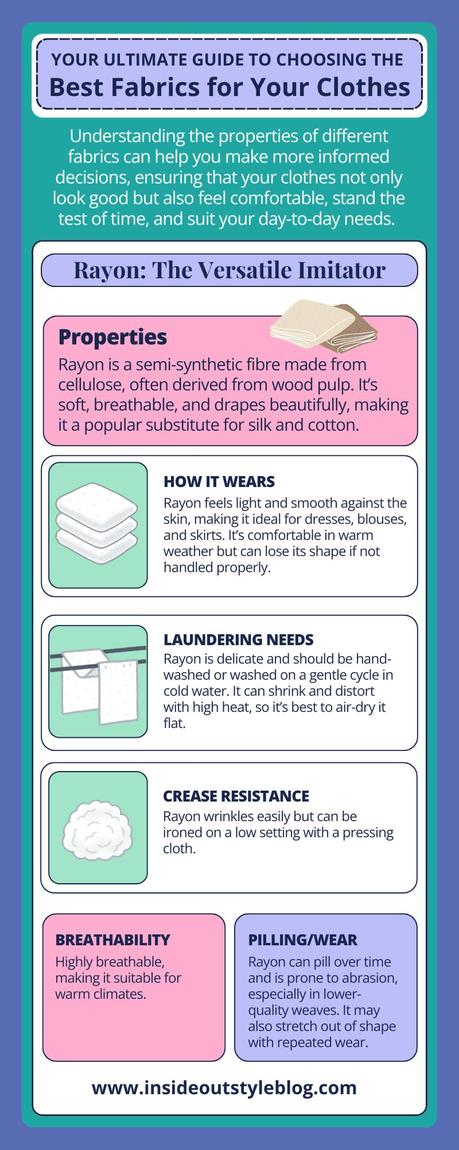 7. Viscose: The Everyday Luxury
7. Viscose: The Everyday Luxury

Properties: Viscose is a type of rayon, also made from cellulose fibres. It's soft, and smooth, and has a silk-like appearance with a subtle sheen.
How It Wears: Viscose drapes well and feels luxurious, making it perfect for flowing garments like dresses, blouses, and skirts. It's comfortable to wear but can be fragile when wet.
Laundering Needs: Viscose requires careful laundering. It's best hand-washed or machine-washed on a delicate cycle in cold water. It should be laid flat to dry, as it can stretch and lose shape when wet.
Crease Resistance: Viscose tends to wrinkle easily, but creases can be smoothed out with a cool iron.
Breathability: It's breathable, making it a good option for warm-weather clothing.
Pilling/Wear: Viscose can pill with wear, especially in high-friction areas, and it can weaken over time with repeated laundering.
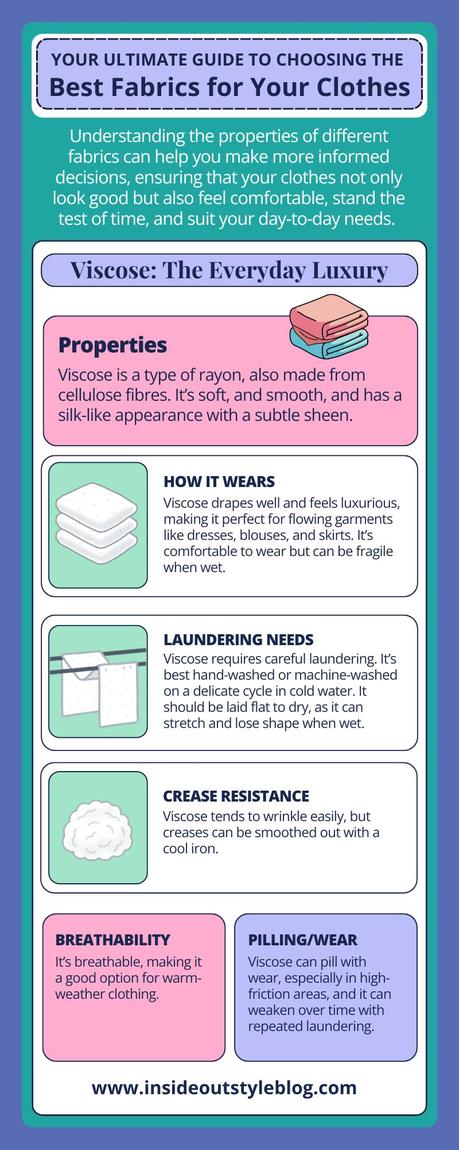 8. Modal: The Silky Softness
8. Modal: The Silky Softness

Properties: Modal is a type of rayon made from beech tree pulp. It's known for its softness, breathability, and resistance to shrinking and fading.
How It Wears: Modal is exceptionally soft and smooth, often used in intimate apparel, activewear, and loungewear. It has excellent drape and movement.
Laundering Needs: Modal is relatively easy to care for compared to other rayons. It can be machine-washed in cold water and tumble-dried on low, but air-drying is recommended to maintain its softness.
Crease Resistance: Modal is more resistant to creasing than regular rayon but may still wrinkle slightly. It can be ironed on a low setting if needed.
Breathability: It's highly breathable, making it suitable for layering or standalone pieces in various climates.
Pilling/Wear: Modal resists pilling and retains its softness and colour well, even after multiple washes.
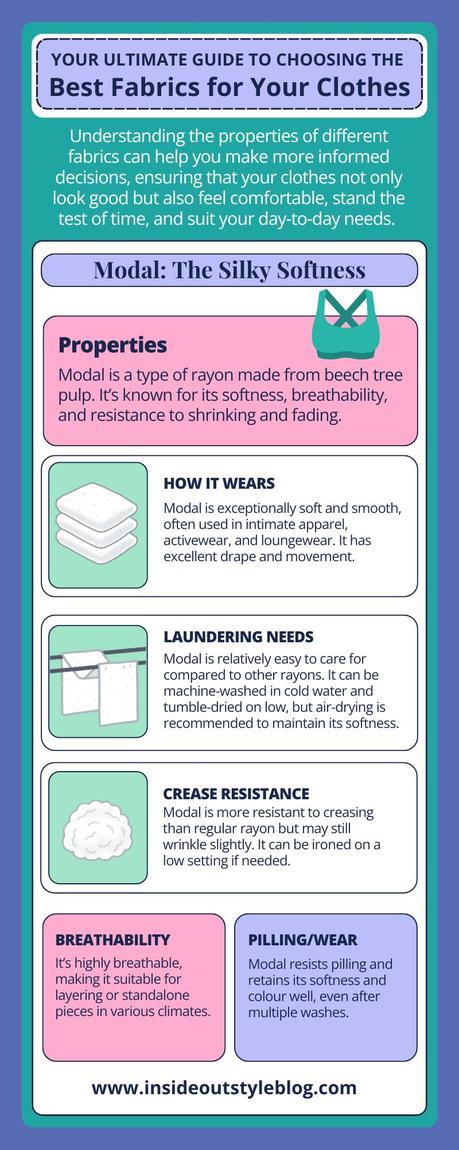 9. Lyocell (Tencel): The Eco-Friendly Innovator
9. Lyocell (Tencel): The Eco-Friendly Innovator

Properties: Lyocell, often branded as Tencel, is a type of rayon made from sustainably sourced wood pulp. It's known for its strength, softness, and eco-friendly production process.
How It Wears: Lyocell has a smooth, silky texture and drapes beautifully. It's versatile enough for both casual and formal wear and is often blended with other fibres to enhance its properties.
Laundering Needs: Lyocell is relatively easy to care for. It can be machine-washed on a gentle cycle in cold water and either tumble-dried on low or air-dried. Avoid high heat to prevent shrinkage.
Crease Resistance: Lyocell resists wrinkles better than cotton but may still require light ironing or steaming.
Breathability: It's highly breathable and moisture-wicking, making it ideal for activewear and warm-weather garments.
Pilling/Wear: Lyocell is durable and resistant to pilling, maintaining its appearance and feel over time.
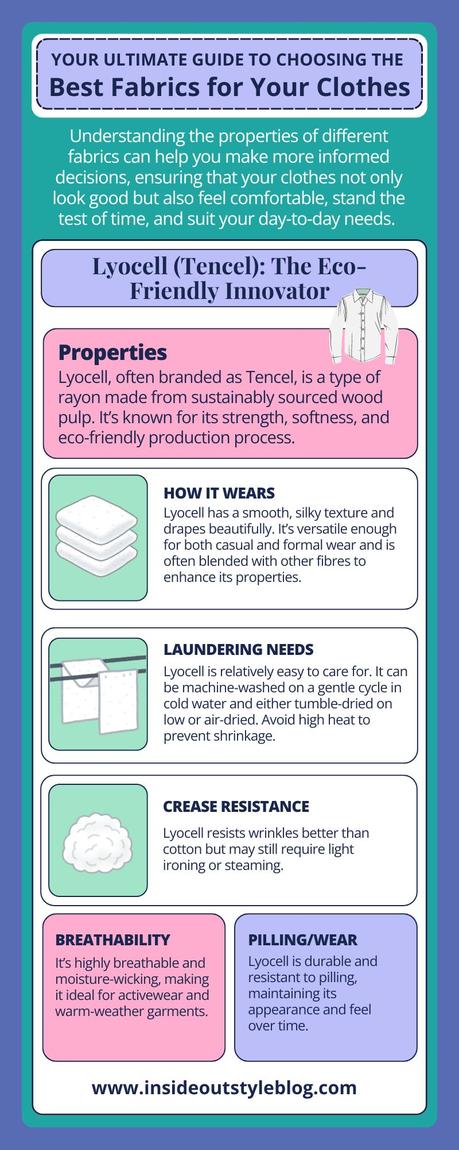 10. Acrylic: The Synthetic Substitute
10. Acrylic: The Synthetic Substitute

Properties: Acrylic is a synthetic fibre often used as a substitute for wool due to its softness, warmth, and resilience.
How It Wears: Acrylic is lightweight and soft but can sometimes feel less breathable than natural fibres. It's commonly used in sweaters, scarves, and outerwear and wears poorly pilling very quickly.
Laundering Needs: Acrylic is easy to care for and can be machine-washed in warm water. However, it's prone to static and can shrink if exposed to high heat, so it's best to air-dry.
Crease Resistance: Acrylic is resistant to creasing and holds its shape well, even after washing.
Breathability: Less breathable than natural fibres, which can make it feel warm and sometimes clammy.
Pilling/Wear: Acrylic tends to pill very quickly and should be avoided.
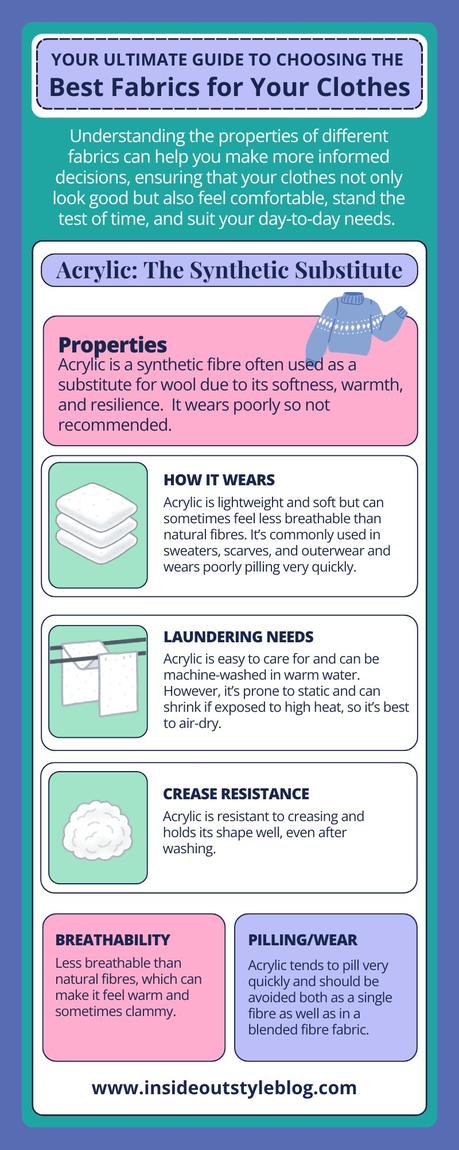 11. Bamboo: The Sustainable Choice
11. Bamboo: The Sustainable Choice

Properties: Bamboo fabric is made from the pulp of bamboo plants. It's soft, breathable, and often marketed as a sustainable and eco-friendly fabric.
How It Wears: Bamboo fabric is soft and smooth, similar to silk or cashmere. It's comfortable and hypoallergenic, making it suitable for sensitive skin.
Laundering Needs: Bamboo fabric should be washed on a gentle cycle in cold water and air-dried to maintain its softness and shape.
Crease Resistance: Bamboo is more crease-resistant than cotton but may still wrinkle. Light ironing or steaming can smooth out creases.
Breathability: Bamboo is highly breathable and moisture-wicking, making it ideal for warm-weather wear and activewear.
Pilling/Wear: Bamboo fabric can pill over time, especially in areas of friction, but high-quality weaves tend to be more resistant.
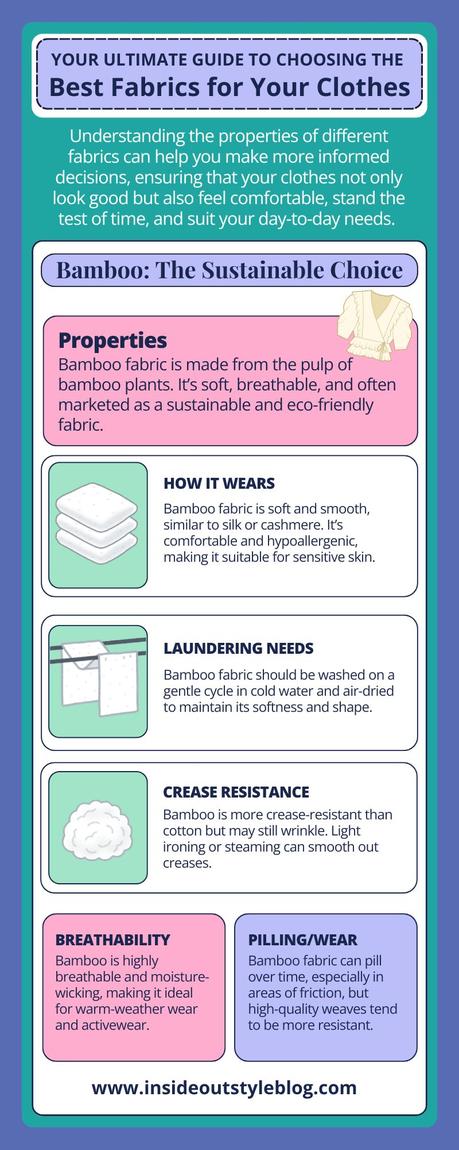 12. Ponte: The Structured Stretch
12. Ponte: The Structured Stretch

Properties: Ponte is a double-knit fabric that combines different fibres such as rayon, polyester, and spandex/elastane. It's known for its firmness, stretch, and smooth finish.
How It Wears: Ponte is thick, firm, and stretchy, providing structure and support while still being comfortable. It's often used for tailored garments like dresses, blazers, and pants.
Laundering Needs: Ponte can generally be machine-washed in cold water and air-dried. Avoid high heat to preserve the fabric's elasticity.
Crease Resistance: Ponte resists creasing well, maintaining a smooth, polished appearance even after extended wear.
Breathability: It's less breathable due to its thicker structure, making it more suitable for cooler weather or structured pieces.
Pilling/Wear: Ponte is durable and resists pilling, making it a long-lasting fabric for everyday wear.
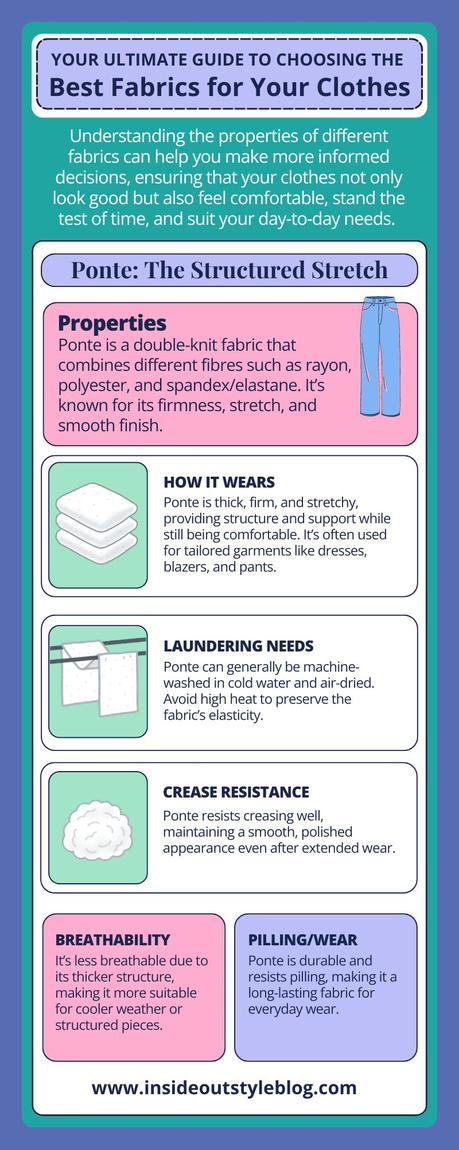 Types of Wools
Types of Wools

1. Cashmere: The Pinnacle of Luxury
Properties: Cashmere is a natural fibre obtained from the undercoat of cashmere goats, primarily found in the Himalayan regions. It is renowned for its exceptional softness, lightweight warmth, and luxurious feel.
How It Wears: Cashmere garments are incredibly soft and provide a high level of insulation without being bulky. They are perfect for layering during cooler months and feel lightweight yet cosy. Cashmere is often used in sweaters, scarves, and cardigans.
Laundering Needs: Cashmere requires gentle care to maintain its softness and structure. Hand-washing in cold water with a mild detergent specifically designed for wool or cashmere is recommended. Gently press out excess water and lay the garment flat to dry, avoiding direct sunlight or heat. Some cashmere garments can be dry-cleaned, but frequent dry cleaning can strip the fibres of their natural oils.
Crease Resistance: Cashmere is naturally resistant to creasing, so it retains a smooth, polished appearance with minimal care.
Breathability: Cashmere is highly breathable and temperature-regulating, making it comfortable in a range of climates. It provides warmth without causing overheating.
Pilling/Wear: Cashmere can pill, especially in areas of friction, such as under the arms or at the elbows. Higher-quality cashmere, made from longer fibres, tends to pill less and wear better over time. Regular gentle de-pilling can help maintain the garment's appearance.
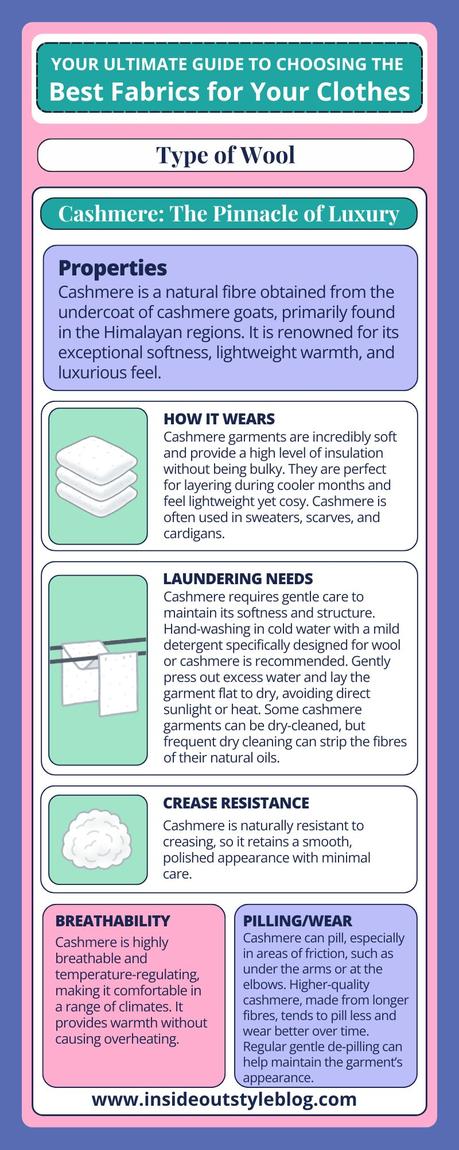 2. Alpaca: The Sustainable Softness
2. Alpaca: The Sustainable Softness

Properties: Alpaca fibre is derived from the fleece of alpacas, native to the Andean regions of South America. It is prized for its softness, durability, and natural hypoallergenic properties. Alpaca is available in two main types: Huacaya, which is softer and fluffier, and Suri, which is silkier and smoother.
How It Wears: Alpaca garments are incredibly warm and soft, often compared to cashmere but with a slightly silkier feel. They provide excellent insulation and are less prone to pilling and shedding. Alpaca is often used in sweaters, scarves, coats, and blankets.
Laundering Needs: Similar to cashmere, alpaca requires gentle care. Hand-washing in cold water with a gentle detergent is recommended. Avoid wringing or twisting the fabric; instead, press gently to remove excess water and lay flat to dry. Some alpaca garments may be dry-cleaned, but it's best to check the care label.
Crease Resistance: Alpaca has good crease resistance and retains its shape well, making it ideal for structured garments like coats and jackets.
Breathability: Alpaca is breathable and provides excellent temperature regulation. It's warmer than wool and can be comfortably worn in both cool and moderate climates.
Pilling/Wear: Alpaca is more resistant to pilling than cashmere and wool due to its longer, smoother fibres. It is also highly durable, making it a long-lasting addition to any wardrobe.
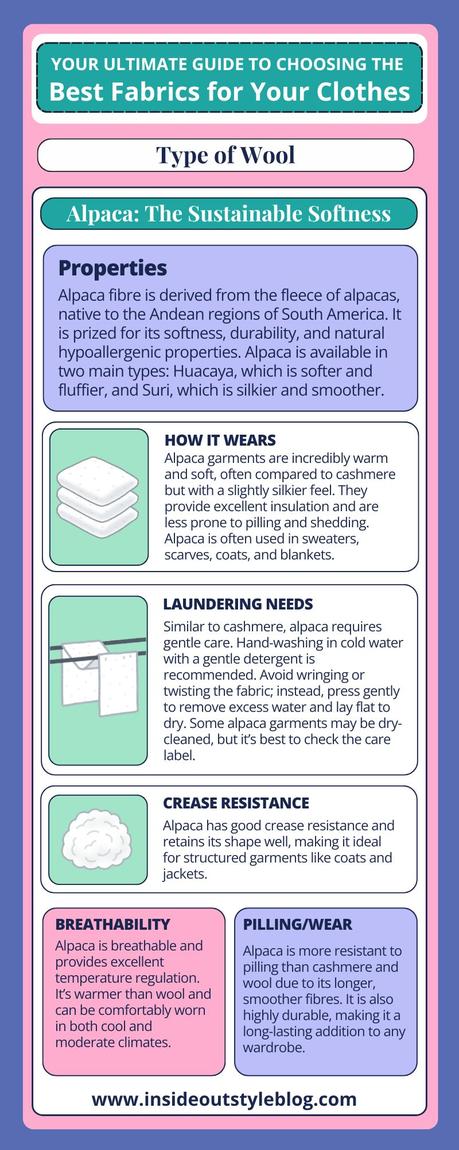 3. Merino Wool: The Fine, Soft All-Rounder
3. Merino Wool: The Fine, Soft All-Rounder

Properties: Merino wool comes from Merino sheep, primarily bred in Australia and New Zealand. It is renowned for its exceptional softness, fine fibre diameter (usually around 18-24 microns), and excellent moisture-wicking and temperature-regulating properties.
How It Wears: Merino wool is lightweight, soft, and comfortable against the skin, making it ideal for base layers, sweaters, and activewear. It's less itchy than coarser wools and can be worn directly against the skin without irritation.
Laundering Needs: Many merino wool garments are machine washable, but it's best to use a gentle cycle with cold water and lay flat to dry. Always check the care label for specific instructions.
Breathability and Warmth: Merino is highly breathable and effective at regulating body temperature, keeping you warm in cold weather and cool in warmer conditions. It also has natural antibacterial properties, making it less prone to odour.
Durability and Pilling: Merino wool is generally more delicate than other types of wool and can pill with wear, especially in high-friction areas. Higher-quality merino, made from longer fibres, is more resistant to pilling.
Best For: Base layers, lightweight sweaters, activewear, and socks due to their softness, breathability, and moisture-wicking properties.
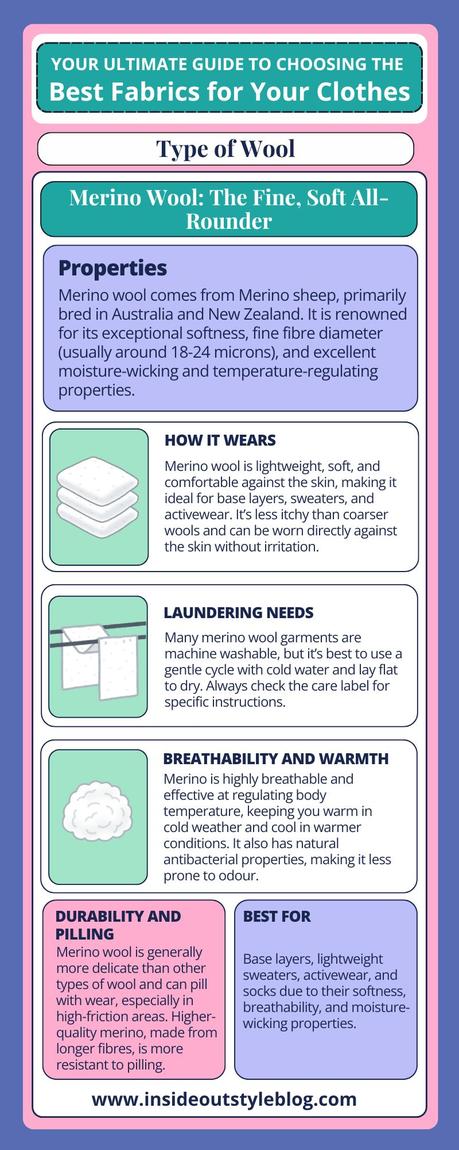 4. Lambswool: A Sturdy Choice
4. Lambswool: A Sturdy Choice

Properties: Lambswool comes from the first shearing of a lamb, usually around six to eight months old. It is soft, fine, and more elastic than regular wool, with a fibre diameter typically between 21 and 24 microns. It has a shorter fibre which means it pills more easily and can feel more scratchy.
How It Wears: Lambswool is warm but not as soft as Merino. It's often used in knitwear like sweaters, scarves, and gloves. While it's not as fine as Merino, it is still comfortable when worn with a layer between skin and garment for most people.
Laundering Needs: Hand-washing in cold water with a wool-specific detergent is recommended. Lay flat to dry to avoid stretching or shrinking. Some lambswool garments may be machine washable on a gentle cycle but always check the label.
Breathability and Warmth: Lambswool is warm and breathable, making it suitable for cool weather. It provides good insulation while allowing moisture to escape, keeping you comfortable.
Durability and Pilling: Lambswool will still pill over time, especially in high-friction areas.
Best For: Everyday knitwear like sweaters, cardigans, and scarves that offer a good balance of warmth, softness, and durability.
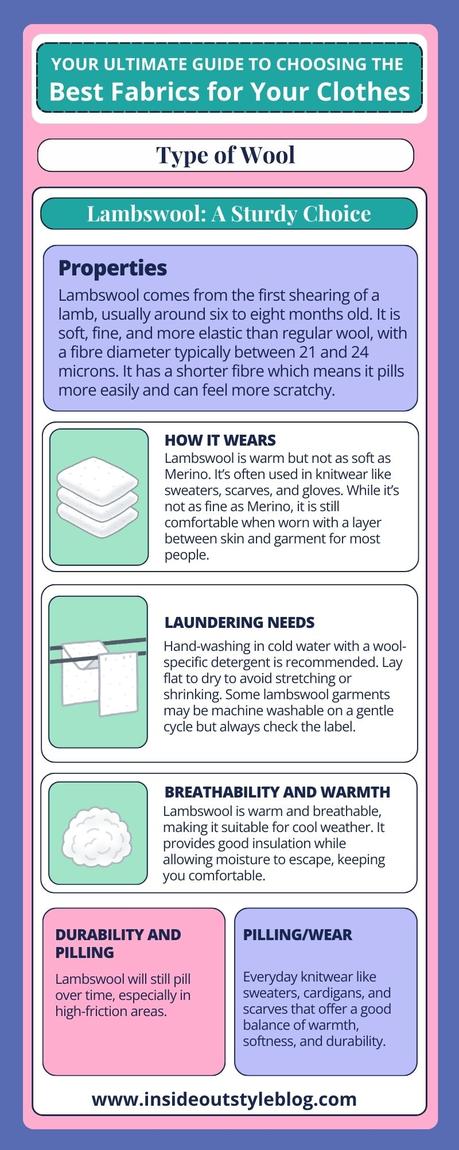 5. Shetland Wool: The Robust Traditional Choice
5. Shetland Wool: The Robust Traditional Choice

Properties: Shetland wool comes from sheep raised in the Shetland Islands, Scotland. It is coarser and more robust than Merino or lambswool, with a fibre diameter typically between 27 and 32 microns.
How It Wears: Shetland wool is durable, warm, and slightly rougher to the touch, making it ideal for outerwear, tweed jackets, and rustic sweaters. It's not typically worn directly against the skin due to its coarseness.
Laundering Needs: Hand-washing in cold water is best. Lay flat to dry and avoid wringing or twisting. Shetland wool is durable but can shrink or felt if exposed to heat and agitation.
Breathability and Warmth: It provides excellent warmth and is highly breathable, making it suitable for harsh climates and outdoor activities.
Durability and Pilling: Shetland wool is very durable and resistant to wear and tear. It's less prone to pilling compared to finer wools, making it ideal for long-lasting garments.
Best For: Sturdy, traditional knitwear, outerwear, and durable sweaters that are built to withstand the elements.
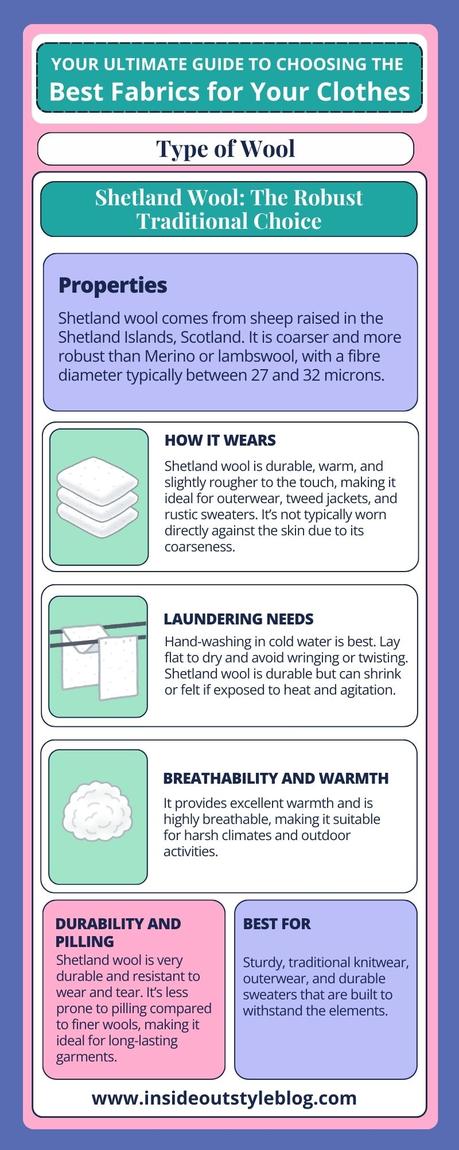 6. Mohair: The Lustrous Shine
6. Mohair: The Lustrous Shine

Properties: Mohair is obtained from the Angora goat and is known for its lustre, sheen, and durability. It's often blended with other fibres to add shine and resilience to fabrics.
How It Wears: Mohair is soft, lightweight, and durable, often used in suits, scarves, and sweaters. It has a natural sheen and is less likely to wrinkle.
Laundering Needs: Mohair should be hand-washed in cold water or dry-cleaned. Avoid excessive agitation and high temperatures to prevent damage.
Breathability and Warmth: It's warm and breathable, making it comfortable to wear in various climates. It's also moisture-wicking, keeping you dry and comfortable.
Durability and Pilling: Mohair is resistant to pilling and retains its shape well. Its durability makes it suitable for long-lasting garments.
Best For: Adding a touch of luxury and shine to knitwear, coats, and suits, or blending with other fibres for a softer, more lustrous fabric.
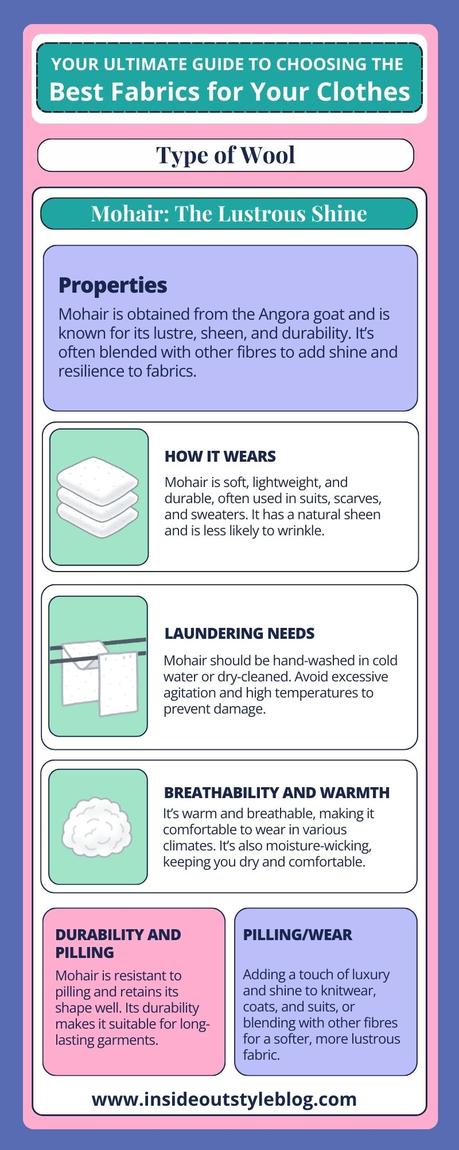 Fabric Blends: The Best of Both Worlds?
Fabric Blends: The Best of Both Worlds?

Properties: Fabric blends combine the strengths of different fibers to create more versatile textiles. Common blends include cotton-polyester, wool-silk, and spandex blends.
Choosing the Right Fabric for Your Wardrobe
Understanding the properties of various fabrics and blends is essential for building a wardrobe that not only looks stylish but also aligns with your lifestyle and comfort needs. Here's a quick guide to help you choose the right fabric based on your priorities:
- For Breathability: Choose natural fibres like cotton, linen, bamboo, and lyocell.
- For Durability: Look for wool, polyester blends, and high-quality rayon or modal.
- For Ease of Care: Polyester, acrylic, and fabric blends are generally more resilient and easy to maintain.
- For a Luxurious Feel: Silk, viscose, modal, and lyocell offer a soft, smooth texture that feels luxurious against the skin.
- For Warmth: Wool and cashmere are great options for colder climates, while thicker fabrics like ponte provide structure and warmth.
1. Denim/Elastane Mix: The Flexible Staple
Properties: This blend typically combines the rugged durability of cotton denim with the added stretch of elastane (also known as spandex or Lycra). The amount of elastane usually ranges from 1-5%, providing flexibility without compromising the structure of the denim.
How It Wears: Denim with elastane is more comfortable and flexible than 100% cotton denim. It allows for better movement and shape retention, making it ideal for fitted jeans, jackets, and skirts. The stretch ensures that garments fit well and recover their shape after wear.
Laundering Needs: Wash in cold water to preserve the elasticity and prevent shrinkage. Turn the garment inside out to reduce fading and avoid tumble-drying, which can weaken the elastane fibres over time.
Crease Resistance: The addition of elastane helps reduce creasing and keeps the denim looking smooth and polished.
Breathability: This blend is slightly less breathable than pure cotton denim due to the elastane, but it still offers good air circulation.
Pilling/Wear: The blend is generally durable, but over time, the elastane can lose its elasticity, especially with frequent washing and high heat. The cotton component may also develop some surface wear or fading with heavy use.
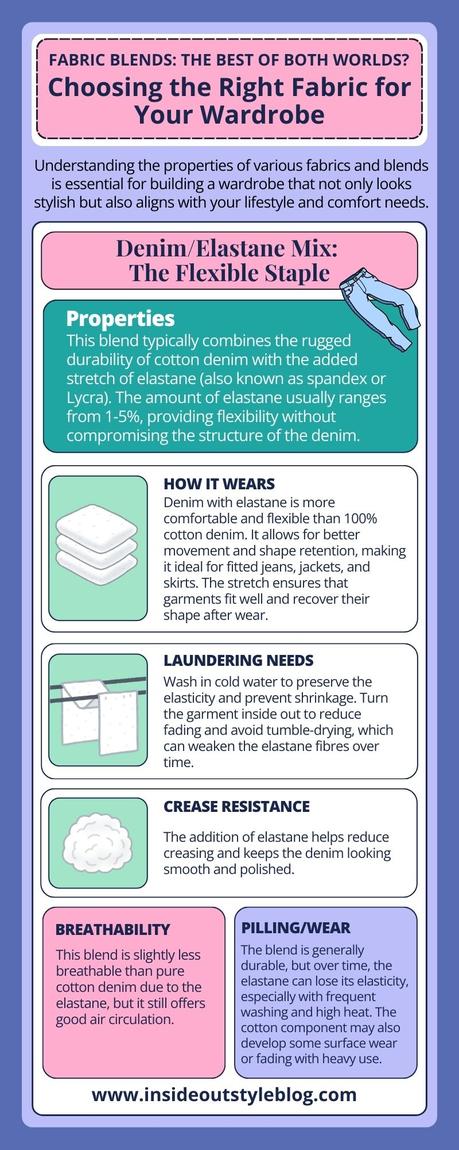 2. Viscose/Polyester Mix: The Silky, Durable Blend
2. Viscose/Polyester Mix: The Silky, Durable Blend

Properties: Viscose adds softness and drape to the blend, while polyester enhances durability, wrinkle resistance, and colour retention. This mix often aims to mimic the luxurious feel of natural fibres with the added benefits of synthetic resilience.
How It Wears: This blend offers the silky feel and flow of viscose with the strength and resilience of polyester. It's commonly used for blouses, dresses, and lightweight tops. The blend maintains its shape and appearance better than pure viscose and is less prone to shrinking.
Laundering Needs: It's generally easy to care for-machine wash on a gentle cycle in cold water and air-dry to prevent any damage to the viscose component. Polyester reduces the likelihood of shrinking and wrinkling.
Crease Resistance: This blend is more wrinkle-resistant than pure viscose but may still require light ironing or steaming for a polished look.
Breathability: The blend is less breathable than pure viscose, but it still offers decent airflow and comfort in moderate climates.
Pilling/Wear: Polyester reduces the tendency for pilling that pure viscose can have, making this blend more durable and less prone to surface wear.
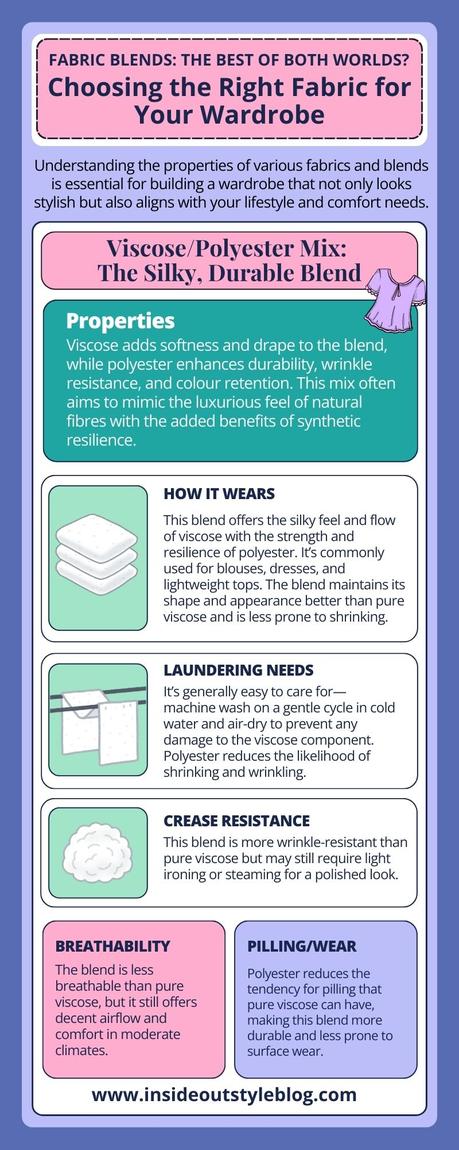 3. Cotton/Polyester Mix: The All-Purpose Blend
3. Cotton/Polyester Mix: The All-Purpose Blend

Properties: Combining cotton's breathability and comfort with polyester's durability and wrinkle resistance, this is one of the most common and versatile fabric blends.
How It Wears: Cotton-polyester blends are comfortable, durable, and retain their shape well. They're often used in T-shirts, casual shirts, and activewear. The blend is softer and more breathable than pure polyester but less prone to shrinking and fading than pure cotton.
Laundering Needs: Machine washable and easy to care for, this blend can usually withstand tumble-drying. Avoid high heat to prevent potential shrinking or damage.
Crease Resistance: This blend is more wrinkle-resistant than pure cotton but can still crease, particularly in higher-cotton-content blends.
Breathability: The higher the cotton content, the more breathable the fabric. Blends with more polyester may feel warmer and less breathable.
Pilling/Wear: The blend is more resistant to pilling and wear than pure cotton, making it suitable for everyday wear and tear.
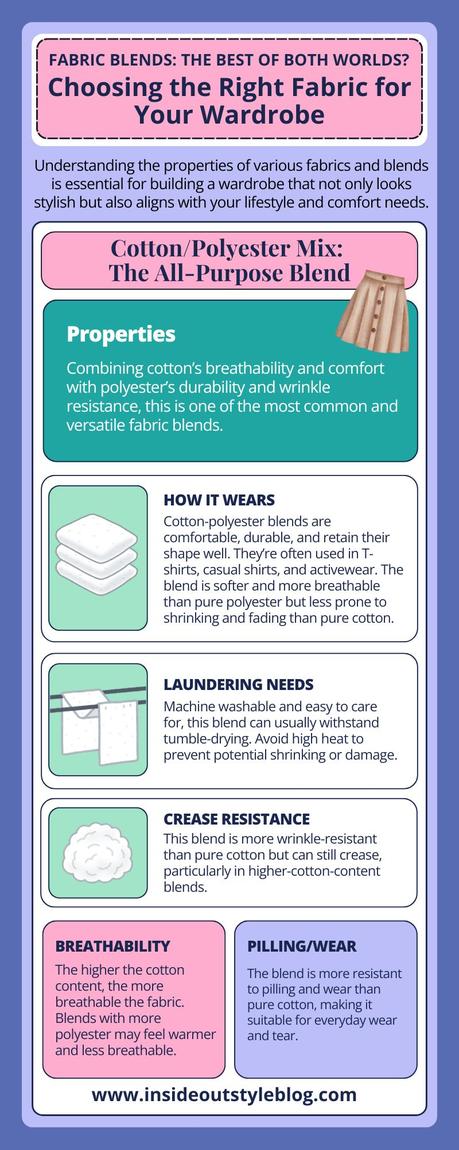 4. Wool/Polyester Mix: The Durable Comfort
4. Wool/Polyester Mix: The Durable Comfort

Properties: This blend combines the warmth, breathability, and softness of wool with the durability and wrinkle resistance of polyester. It's often used for suits, outerwear, and winter clothing.
How It Wears: The blend provides the cosy, insulating properties of wool while being more resistant to shrinkage and creasing. It's less scratchy than pure wool, making it more comfortable for sensitive skin.
Laundering Needs: Dry clean or hand wash in cold water with a gentle detergent. Air-dry flat to maintain the fabric's shape and prevent shrinkage.
Crease Resistance: Polyester reduces the wrinkling tendency of wool, so garments remain smoother for longer.
Breathability: The blend remains fairly breathable due to the wool content but can feel warmer and less airy than pure wool.
Pilling/Wear: Blends are generally more resistant to pilling and wear, though some surface fuzzing may occur over time, especially in high-friction areas.
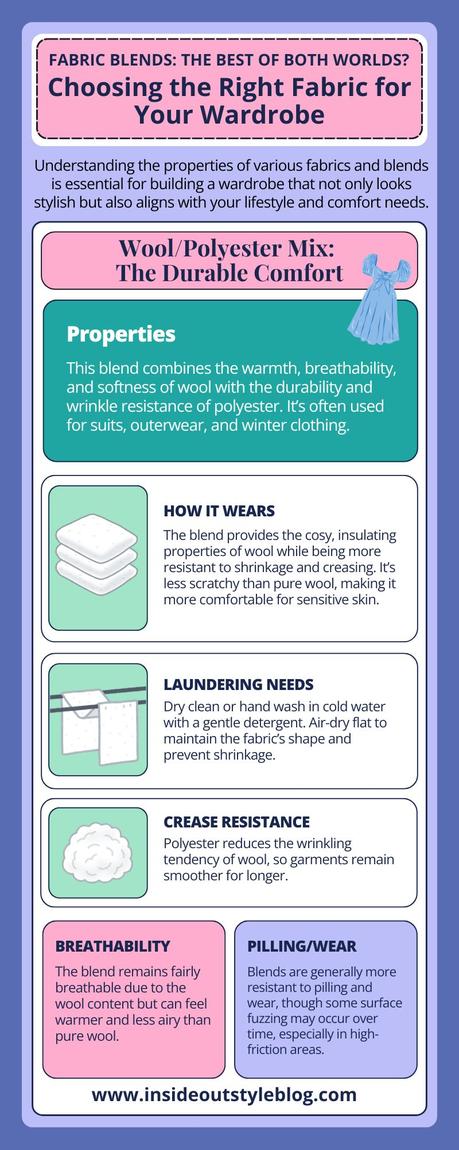 5. Rayon/Nylon/Spandex Mix: The Stretchy Comfort
5. Rayon/Nylon/Spandex Mix: The Stretchy Comfort

Properties: Rayon provides softness and drape, nylon adds durability, and spandex offers stretch. This blend is often used in leggings, activewear, and fitted garments.
How It Wears: The blend is comfortable, stretchy, and holds its shape well. It's ideal for active or fitted clothing where flexibility and movement are key. It drapes nicely while still providing support and recovery.
Laundering Needs: Machine wash on a gentle cycle in cold water and air-dry to preserve elasticity and prevent shrinkage or distortion.
Crease Resistance: The spandex component helps maintain a smooth appearance, reducing the need for ironing.
Breathability: This blend is less breathable than pure natural fibres, but the rayon component adds some breathability, making it suitable for a range of temperatures.
Pilling/Wear: Nylon and spandex enhance durability, reducing the pilling and wear that pure rayon might experience. However, high-friction areas may still show wear over time.
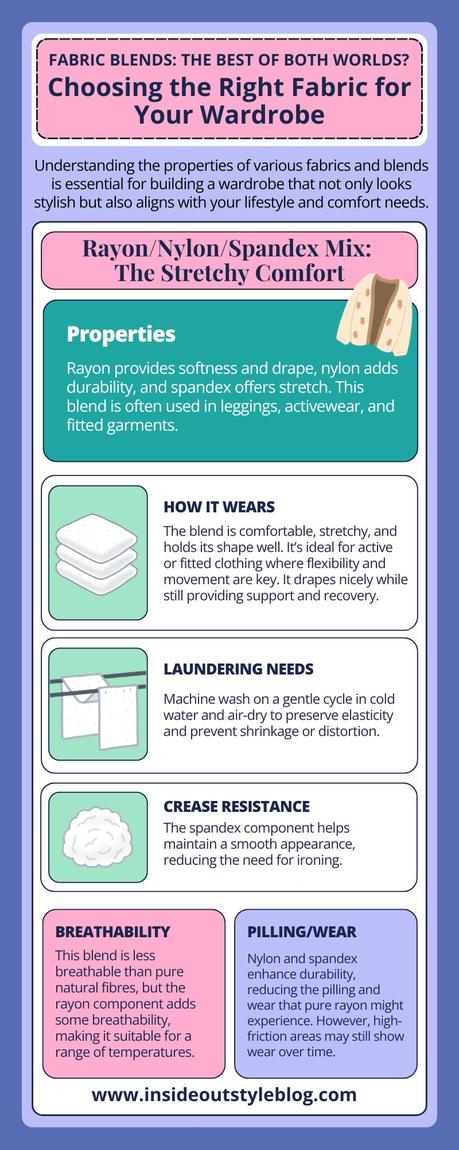 6. Bamboo/Cotton Mix: The Soft, Sustainable Blend
6. Bamboo/Cotton Mix: The Soft, Sustainable Blend

Properties: Bamboo adds softness and breathability, while cotton enhances the blend's structure and durability. This blend is often used in casual wear, loungewear, and activewear.
How It Wears: The blend is soft and comfortable, with a natural feel. It's breathable and moisture-wicking, making it ideal for warm weather or active settings.
Laundering Needs: Machine wash in cold water on a gentle cycle. Air-dry to maintain the softness and prevent shrinking.
Crease Resistance: This blend is less prone to wrinkling than pure cotton, but it can still develop light creases. A quick steam or iron can smooth them out.
Breathability: The blend is highly breathable, making it a great choice for hot climates or activewear.
Pilling/Wear: Bamboo fibres can pill with wear, but the cotton component adds strength and durability, reducing the likelihood of surface wear.
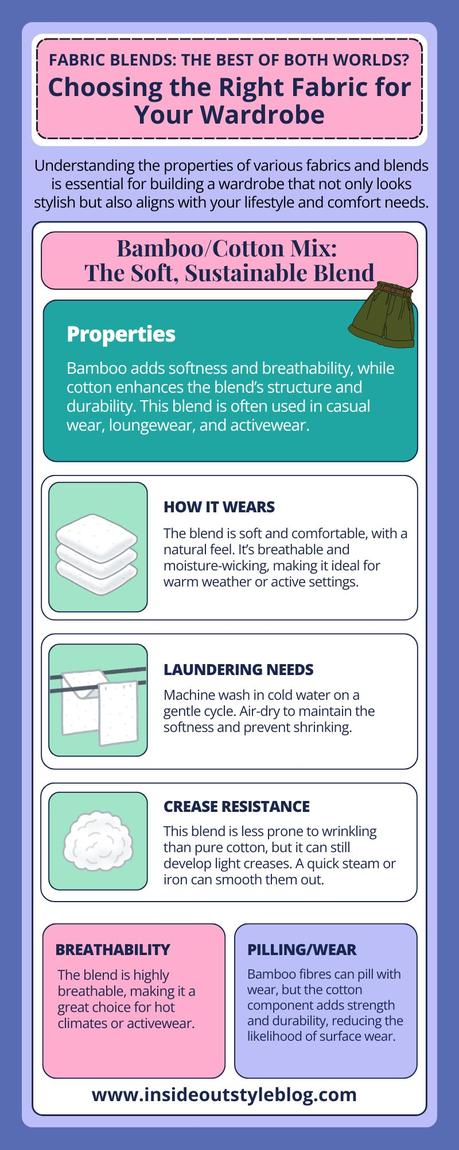 7. Cashmere/Elastane Mix: The Stretchy Luxury
7. Cashmere/Elastane Mix: The Stretchy Luxury

Properties: This blend adds a small amount of elastane to cashmere, enhancing its flexibility and shape retention without sacrificing softness.
How It Wears: The blend provides the luxurious feel of cashmere with added stretch, making it ideal for fitted sweaters and accessories. It retains its shape better than pure cashmere.
Laundering Needs: Follow cashmere care guidelines, with added caution due to the elastane. Avoid high heat and excessive wringing, and lay flat to dry.
Pilling/Wear: While cashmere/elastane blends may still pill, the elastane can enhance the garment's durability and resistance to deformation.
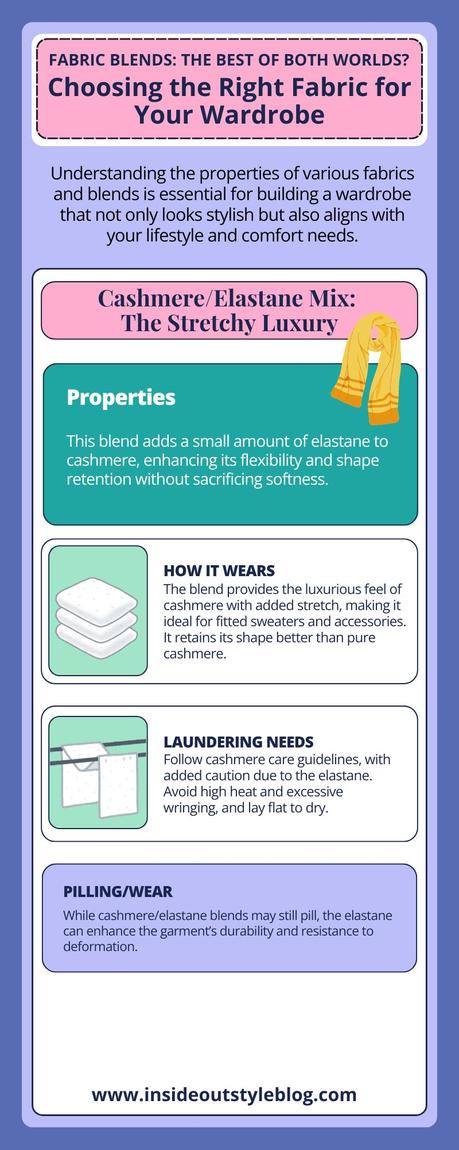
8. Alpaca/Wool Blend: The Durable Warmth
Properties: This blend combines the softness and warmth of alpaca with the structure and resilience of wool. It's often used in heavy winter garments like coats and thick sweaters.
How It Wears: The blend provides superior warmth and comfort with a structured appearance. It's less prone to stretching out or losing shape compared to pure alpaca.
Laundering Needs: Hand-wash or dry clean depending on the garment's construction. Air-dry to avoid shrinkage or felting.
Pilling/Wear: This blend is highly durable and resists pilling better than pure alpaca or wool alone, making it a practical yet luxurious option.
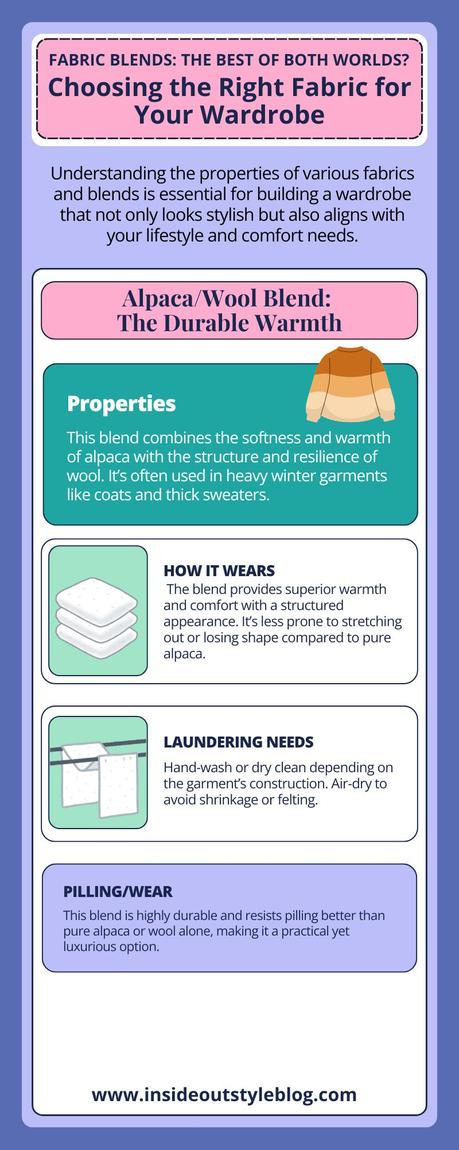 9. Cashmere/Cotton Mix: The Lightweight Luxury
9. Cashmere/Cotton Mix: The Lightweight Luxury

Properties: Combining cashmere with cotton creates a lightweight, breathable fabric that retains cashmere's softness with the added breathability and structure of cotton.
How It Wears: This blend is ideal for transitional pieces like lightweight sweaters and cardigans. It offers a softer feel than pure cotton and is more breathable than pure cashmere.
Laundering Needs: Wash gently in cold water, and air-dry flat to maintain the blend's integrity.
Pilling/Wear: While more resistant to pilling than pure cashmere, the blend may still develop some surface wear over time, especially in high-friction areas.
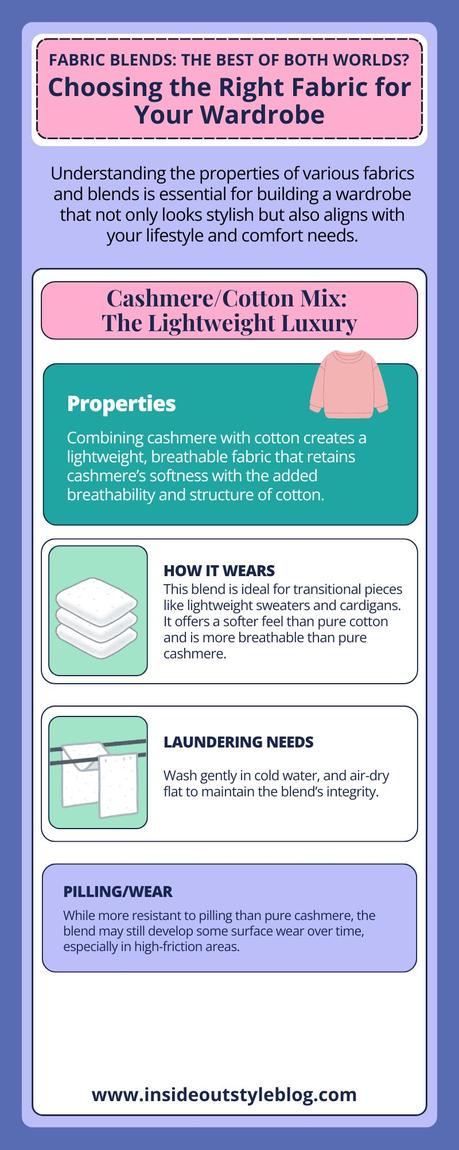 Choosing the Right Fabric Blend for Your Needs
Choosing the Right Fabric Blend for Your Needs

Blended fabrics offer a balance of qualities that make them versatile and practical for different uses. Here's a quick guide to help you decide which blend suits your needs:
- For Comfort and Stretch: Look for blends with elastane or spandex, such as denim/elastane or rayon/nylon/spandex.
- For Durability and Ease of Care: Polyester blends like cotton/polyester or wool/polyester are excellent for durability and low-maintenance care.
- For Softness and Breathability: Blends like bamboo/cotton or rayon/nylon provide a soft, breathable feel suitable for sensitive skin or warm weather.
- For Structure and Shape: Ponte (a blend of various fibres) and wool blends offer structure while maintaining comfort and resilience.
Phew! That's a lot to take in which is why I'm making this a free download. Understanding how different fabric blends perform can help you make better choices when shopping for clothing that fits your lifestyle and style preferences. Whether you need something stretchy and comfortable for activewear or durable and easy to care for in everyday attire, there's a fabric blend out there to meet your needs.



